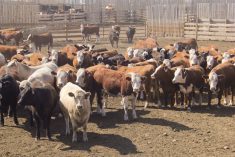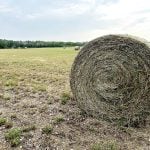The early harvest of grain and oilseed crops in Western Canada allowed for increased seeding of winter wheat and for the crop to get off to a good start, according to industry participants.
"The opportunity to increase the seeded area to winter wheat on the Canadian Prairies was there this fall," said Bruce Burnett, a crop and weather specialist with CWB in Winnipeg.
The early harvest of crops, especially in Manitoba, allowed producers to get a good head start in the seeding of the winter wheat crop, he said.
Read Also

U.S. livestock: Feeder cattle hit contract highs on tight supply
Chicago | Reuters – All Chicago Mercantile Exchange feeder cattle futures and most live cattle futures hit contract highs on…
To the downside, however, the emergence of the winter wheat in some areas of Western Canada has been very spotty due to the lack of adequate soil moisture.
"However, the longer temperatures this fall can stay warm and as long as some precipitation is received before the temperatures turn cold and the ground freezes, there is still hope for emergence occurring in those areas," Burnett said.
Winter wheat seeded in western Manitoba and eastern Saskatchewan were the most critically in need of additional precipitation.
Some winter wheat crops did emerge late because of the poor soil moisture when farmers seeded those fields.
Dryness in winter wheat fields heading into the winter can reduce the yield and quality potential of the crop in the spring, Burnett said.
Yields in winter wheat are closely related to the density of the crop and certainly the number of leaves of growth per plant that occurs in the fall.
"Non-traditional" demand
Jake Davidson, executive director with Winter Cereals Canada at Minnedosa, Man., agreed that with the early harvest of crops in parts of the Prairies, a fair amount of winter wheat was seeded this fall. However, he said estimates on exactly how much was seeded are still being determined by his group.
"The positives of strong demand and the harvest of a crop that had strong yields and was of good quality this summer definitely helped to encourage some area to the crop this fall in Western Canada," Davidson said.
Dealers in western Canada reported a good run on winter wheat seed sales, he said.
The demand for winter wheat produced in Western Canada was linked to the shortage of feed- and milling-quality wheat in the U.S., Davidson said.
"With the free market changes in Western Canada (meaning the removal of the Canadian Wheat Board as the sole marketer of wheat) there was exceptional demand from non-traditional outlets, especially from the U.S.," Davidson said. "There were a lot of calls from the U.S. asking about the quality of the winter wheat in Western Canada and how much was available."
Davidson acknowledged that the recently seeded crop was mostly off to a good start, but there have also been a lot of concerns expressed about dryness and the potential impact on the crop.
"The dryness in Saskatchewan has not concerned farmers who seeded the crop to any great extent, as there was still hope that the needed moisture will fall and help germinate the crop,|" he said.
Seeded area to winter wheat in the fall of 2011 totalled 1.245 million acres, based on data from Statistics Canadaa This surpassed the 2010 level of 575,000 acres and was just shy of the record established in the fall of 2008 when 1.370 million acres were seeded.
— Dwayne Klassen writes for Commodity News Service Canada, a Winnipeg company specializing in grain and commodity market reporting.















